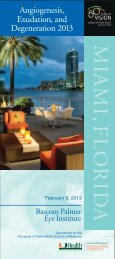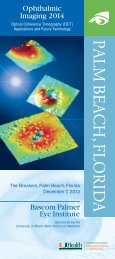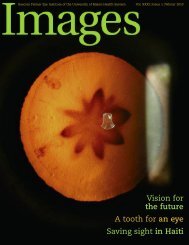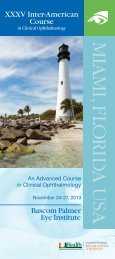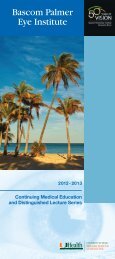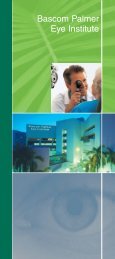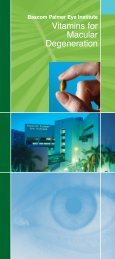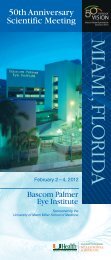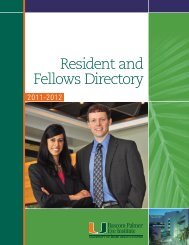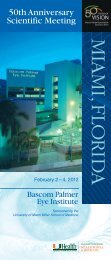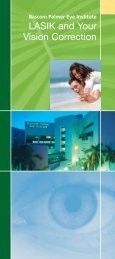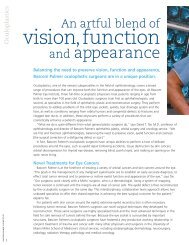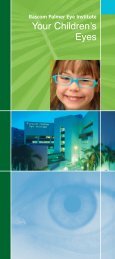Images Magazine Spring 2013 - Bascom Palmer Eye Institute
Images Magazine Spring 2013 - Bascom Palmer Eye Institute
Images Magazine Spring 2013 - Bascom Palmer Eye Institute
- No tags were found...
You also want an ePaper? Increase the reach of your titles
YUMPU automatically turns print PDFs into web optimized ePapers that Google loves.
featureto be recruited by Norton. Throughout their long professional relationship, Norton relied on Curtinto handle a variety of administrative projects, while Curtin also saw patients, interviewed residencycandidates, and maintained the department’s high standards.Along with his clinical and teaching responsibilities, Norton began to reach out to localorganizations and potential donors who could provide the needed funds for a stand-alone eyeclinic. He soon established a close relationship with the Miami Lighthouse for the Blind, which setaside $200,000 in 1959 for construction. Norton and Curtin also became friends with leaders of theFlorida Lions Club, which led to the formation of the Florida Lions <strong>Eye</strong> Bank.The <strong>Institute</strong> OpensWith the support of these organizations, as well as private philanthropists, <strong>Bascom</strong> <strong>Palmer</strong> <strong>Eye</strong><strong>Institute</strong> opened its doors on January 21, 1962, as the first center in the southeast United Statesdevoted exclusively to the study and treatment of the eye. The new institute, located where <strong>Bascom</strong><strong>Palmer</strong>’s Evelyn F. and William L. McKnight Vision Research Center now stands, had 26,000 squarefeet of space in its four floors.J. Lawton Smith, M.D., a neuro-ophthalmologist, joined the faculty in 1962, and focusedhis practice on diagnosing neurological disorders. Recognizing the need to improve physicians’understanding of complex symptoms, the following year, he hosted the nation’s first clinicalpostgraduate educational session devoted to neuro-ophthalmology. The annual scientific meetingcaught on at once and continued for more than 15 years. “Unlike most medical conferences wherepresenters give a lecture illustrated with slides, we had actual patients who could be examined byphysicians attending the course,” Smith said in a 2010 interview. “Our patients benefited by beingable to get multiple opinions on their ophthalmic conditions.”J. Donald M. Gass, M.D., became a faculty member in 1963 and began studying diseases ofthe macula. He soon became a pioneer in the emerging field of fluorescein angiography,a technique in which intravenously injected dye allows the blood vessels in the eye to bephotographed in great detail.Known as the “Father of Macular Diseases,” Gass conceptualized the way in which macularholes form, creating the foundation for surgery on a formerly untreatable condition. In his nearly40 years at <strong>Bascom</strong> <strong>Palmer</strong>, Gass revolutionized the diagnosis and treatment of more than a dozen1965Children’s ClinicfoundedJohn T. Flynn, M.D.,establishesthe children’s clinic andcontinues research onretrolental fibroplasia,later known asretinopathy ofprematurity, a majorcause of blindness innewborns.1966J. Donald M. Gass,M.D.,pioneers the use ofintravenous fluoresceinangiography forthe diagnosis ofintraocular disease,including maculardegeneration. He laterdescribes and classifiesmany of the diseases ofthe macula.7



